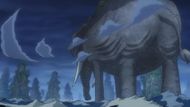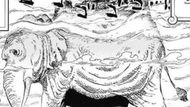Few mysteries in One Piece inspire as much speculation as Zunesha, the colossal elephant sentenced to walk the seas for eternity. This gargantuan creature has lived through the Void Century, was a comrade of Joy Boy himself, and carries the Mink Tribe’s homeland, Zou, upon its back. And yet, despite its size, history, and knowledge, the World Government has allowed it to continue wandering the seas for over 800 years.
Why? Why would the most secretive and controlling entity in the world let a living remnant of the Void Century survive? Why hasn’t the Gorosei ordered an Admiral or Imu directly to cut its legs out from under it? This is the elephant in the room that One Piece fans have debated endlessly.
The canon explanation we’re given is that Zunesha in One Piece is cursed to walk the seas as punishment for a crime committed during the Void Century. It can’t act unless commanded by someone who can hear the “Voice of All Things,” which makes it essentially harmless unless ordered otherwise.

This framing is crucial. From the World Government’s perspective, Zunesha in One Piece isn’t a free, dangerous being. It’s already imprisoned. Unlike the nations they actively destroy (such as Ohara or God Valley), Zunesha is both neutralized and made into a living monument of deterrence.
Killing it might erase a reminder of the Void Century, but letting it wander endlessly reinforces their philosophy of punishment, condemning even allies of Joy Boy to eternal suffering. To the Gorosei, Zunesha is already broken. Its wandering is not freedom, but bondage.
Even if the Government wanted to kill Zunesha in One Piece, the logistics are staggering. This elephant is so large that it can carry an entire island on its back. Its steps span miles, its trunk wipes out fleets, and its very presence dwarfs even Kaido’s dragon form. When Jack of the Beasts Pirates attacked it, Zunesha annihilated his forces with a single swing, despite being injured and restrained by its curse.
Now imagine trying to kill it:
- Devil Fruit users risk drowning if they get close to its legs or body in the open sea.
- Cannon fire is ineffective against something that resists the pressure of the ocean floor daily.
- Admirals could attack, but even they would have to commit enormous energy to bringing it down, risking devastating retaliation.
It’s the equivalent of declaring war on a natural disaster. Even if successful, the cost would be immense.
Zunesha’s location: The phantom island problem in One Piece

Zunesha isn’t just massive, it’s mobile. Unlike Wano, Elbaf, or even the Red Line in One Piece, it can’t be pinned on a map. It’s constantly wandering the New World, without a magnetic field that log poses can track.
The only reliable way to find it is via a vivre card of someone living on Zou. That’s how the Straw Hats located it, not through conventional navigation. Unless the Government keeps constant surveillance (unlikely, given the sheer size of the seas), Zunesha is effectively a phantom island.
The Gorosei themselves once referred to Zou as a “phantom island,” underlining how its mobility makes it near-impossible to locate deliberately. Why launch a massive campaign to destroy something you can’t even consistently track?
Political calculus: Why not kill it anyway?

The World Government has shown no hesitation in destroying entire civilizations for lesser crimes. They annihilated Ohara merely for researching the Void Century. Why not Zunesha?
Several possible reasons emerge:
- Collateral Damage - Zou is home to the Mink Tribe, a powerful warrior race. Killing Zunesha would mean killing the Minks too, inviting backlash or attention from other races and kingdoms.
- Symbolic Power - Letting Zunesha walk may serve as a warning to others. “This is what happens when you side with Joy Boy: you wander forever, broken and punished.”
- Not a Threat - Unlike pirates, revolutionaries, or nations, Zunesha hasn’t taken active steps against the World Government in 800 years. Why expend resources when it poses no immediate danger?
- Uncertainty - If Zunesha was truly Joy Boy’s ally, what if killing it triggers some hidden mechanism tied to the ancient past? Imu might judge that leaving it alive is safer.
The Void Century connection

The biggest reason Zunesha still walks in One Piece may simply be narrative: Oda hasn’t revealed the truth of the Void Century yet. Zunesha is a living witness to Joy Boy’s era. Its punishment is directly tied to that lost history. We don’t know if it's a “great crime,” but speculation ranges from betraying Joy Boy to failing him in battle.
Its continued existence is likely key to Luffy’s eventual uncovering of the past. Destroying Zunesha would erase a major narrative device. For Oda, keeping it alive ensures there’s still a witness to testify when the final war begins.
Final thoughts
Zunesha is not just a giant elephant in One Piece; it’s a symbol of the Void Century, of punishment without death, and of history still walking alongside the present. Its survival reflects both practical limitations (size, location, durability) and narrative necessity (its ties to Joy Boy).
The elephant in the room remains: Zunesha knows Joy Boy. It lived through the century that the Government tried to erase. When the final war arrives, its testimony may prove invaluable to Luffy and the world at large. For now, Zunesha keeps walking, not free, but enduring. And in that endurance lies the possibility that the truth of Joy Boy’s era will finally come to light.
